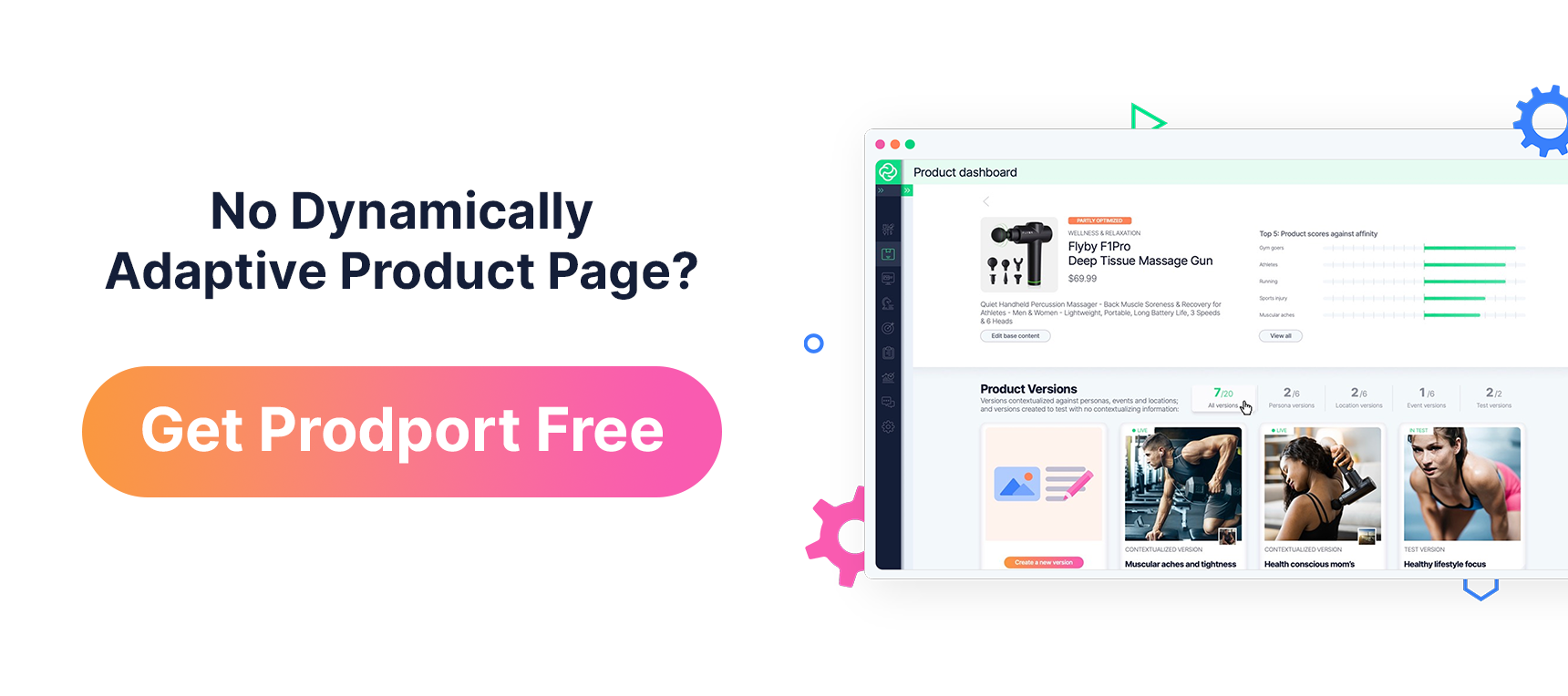In marketing, we have two types of content. The long-term content is that which is rarely changed. You create a category page for a product and it stays mostly the same because it shares foundational data that stays the same year-round for your audience’s varied needs from your products.
The short-term content is often campaign-, persona-, or seasonally-oriented. It’s segmented, has a clear and specific ROI, and is often temporary. However, creating new product pages, especially if it’s just for a short-term campaign, may not seem worth the work because it’s time-consuming and expensive.
Until now, it hasn’t been possible to personalize your product pages in minutes, making it easy and straightforward to personalize for different campaigns or changing segments.
With Prodport you can personalize the experience on your product pages without creating a new theme or page. All the major components remain the same, like design and URL. Instead, we allow you to switch out images, examples, and copy using AI and a streamlined editor.
Learn more about why this type of personalization is so powerful and check out a few examples of Prodport in action.
Why It’s Important
The modern consumer demands personalization. McKinsey found that 71 percent of consumers expect companies to deliver personalized experiences and 76 percent reported getting frustrated if they don’t.
Beyond simply meeting the needs of your customers, product page personalization can offer even more benefits.
- Increase conversion rates: Prodport customers see conversion rate increases of at least 25 percent and many have seen even higher lifts. We always find personalization impacts that bottom line.
- Decrease customer acquisition costs: Prodport clients consistently see reduced costs around customer acquisition once personalized product pages are implemented.
- Boost customer loyalty: McKinsey also found that personalized eCommerce experience increases brand loyalty. Keep your customers around longer by creating pages that speak to them as individuals.
- Remain competitive: GetFeedback’s 2022 report found that 73 percent of businesses report increasing efforts to create a personalized experience. To keep up, you need to focus on personalization as well.
The good news is, with Prodport you can now personalize the most important page—the product page—without spending all the time, money, and effort to create new content, develop new pages, and manage dozens of URLs for the same product.
Even better, you can do this for your long-term landing pages, personalizing for changing seasonality, short-term campaigns, and various personas in minutes.
Who’s Doing It Well
The following examples show you how you can improve your product pages to reduce acquisition costs, increase conversion rates, and stay competitive in your space. We also included some data from a Prodport client to give you an idea of what’s possible for your product pages. Whether you want to shift content for Black Friday or simply appeal to each segment of your audience, you can make it happen with Prodport.
A Sneaker for Everyone
Brand: Adidas
Product: Ultra Boost

While Adidas is not a Prodport customer, they are the perfect example of how personalizing a product page for personas could be a powerful differentiator. The sneaker-buying audience is broad and wide, which means Adidas has an opportunity to personalize the long-term product pages to appeal to various personas. For example, they need pages that appeal to:
- The joggers
- The collectors
- The casual wearer
- Gym goers
By contextualizing their pages, they could dynamically change the product information and content to appeal to each particular customer type. Using Prodport, there’s no limit to how many product page versions you make, allowing you to speak directly to each and every segment of your audience.
Finding the Right Ceiling
Client: Kanopi
Product: INVISACOUSTICS
Page: https://kanopibyarmstrong.com/products/invisacoustics

Not all ceilings are created equal. While most can fit anywhere, businesses are choosing a ceiling for their particular needs, which varies from noise management to occasional impact and sustainability. This means, when looking for the right ceiling on a website, they want to see examples specific to them, like:
- Where it fits
- How it fits
- Suitable colors for their type of establishment
- Specific installations
- Specific case studies
That’s why Kanopi uses Prodport to personalize its product pages. For example, when choosing a ceiling option designated for offices, restaurants, for retail school or healthcare settings the images, examples, and other important details are personalized for that segment of shoppers.
This has led to a 30 percent increase in conversions and they’ve made 4X-4.5X back what they invested in using Prodport.
The latter is a good example of a product that answers different needs to different audiences. These needs are permanent and can’t be solved in the product page due to the ecommerce backend architecture. These are long term needs for the ecommerce manager.
Let’s move to short term campaign based needs examples of the marketer
Finding the Right Ceiling
Client: Furesque
Product: Personalized portraits
Page:


Each portrait is customized for order To generate demand, Furesque sendsemail and SMS to known customers (1st party data) and offers them a gift when ordering for Black Friday. They are sending all the traffic directly to the product page, are using the imagery on the product to explain how the campaign works, and the copy of the product and title for the discount and offers. All of which will be displayed only to the audiences of the campaign. The campaign will end when the audience will stop responding to the email and SMS’s campaigns.
Personalize Your Product Pages—in Any Way—In Minutes
It’s never been easier to personalize your long-term product pages for short-term needs, whether it’s a specific campaign or a new persona. Leverage the power of Prodport to make these changes, and as a result, increase conversions, waste less time, and spend less money.

